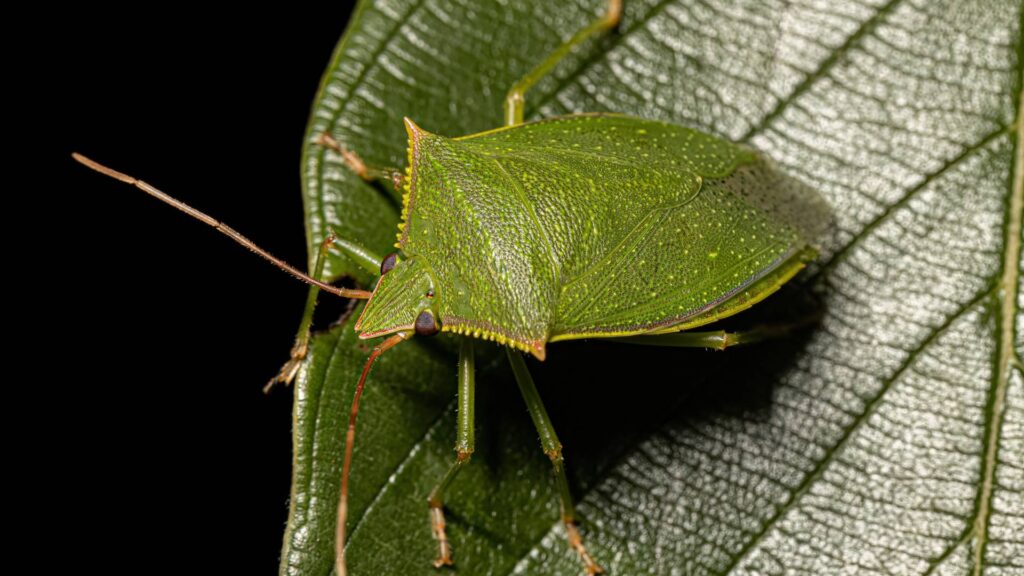Table Of Content
ToggleAs a pest control expert, I’m here to address a common nuisance: stink bugs. These smelly invaders not only disrupt your peace of mind but can also damage your plants. But fear not, there’s a natural solution – diatomaceous earth, often called DE for short, can effectively eliminate these unwelcome guests.
This guide will equip you with everything you need to know about using DE to kill stink bugs and banish them from your home and garden.
Diatomaceous earth (DE), a marvel formed by nature itself, is a powerful weapon in your fight against unwanted pests like stink bugs. But what exactly is DE? Let’s delve into its fascinating origins and properties.
From Microscopic Giants to Pest Control Powerhouse: DE is a naturally occurring, fossilized powder composed of the skeletal remains of diatoms. These diatoms are single-celled algae with hard outer shells made primarily of silica, the same component found in sand and glass. Over millions of years, the accumulated remains of these tiny aquatic organisms have formed sedimentary deposits that are mined and processed into the DE powder we use today.
Beyond Beauty: The Microscopic Power of DE: While DE can be impressive under a microscope, its true power lies in its microscopic structure. Each diatom frustule (shell) is like a miniature grinding wheel, with razor-sharp edges due to the silica content. This unique structure is what makes DE so effective against insects like stink bugs.
Food-Grade vs. Pool-Grade DE: Choosing the Right Weapon: It’s important to note that there are two main types of DE available: food-grade and pool-grade.
Remember: When tackling a stink bug problem, always opt for food-grade DE for a safe and effective solution.
Tailor your pest management strategy. Start now.

Diatomaceous earth disrupts the waxy outer layer of stink bugs, causing dehydration and death.
DE works its magic through its physical properties. The microscopic, sharp edges of DE particles act like tiny knives when insects crawl through them. This damages the waxy outer layer (exoskeleton) of the stink bug, causing it to dehydrate and eventually die.
Indoor Application:
Outdoor Application:
Safety Precautions:
Advantages:
Limitations:
Choose the best pest control frequency. Get expert guidance.

While diatomaceous earth is a powerful tool, it’s not the only weapon in your stink bug arsenal. Here’s a look at some complementary strategies for a well-rounded defense:
Secure your home with the right pest control plan. Find out how.
Think of these tips as preventative measures to make your home less attractive to stink bugs in the first place:
By combining these methods with the use of diatomaceous earth, you can create a comprehensive strategy to keep stink bugs at bay and enjoy a pest-free home.

As a pest control expert, I recommend a multi-pronged approach for severe infestations. Combining DE application with sealing entry points and using traps can significantly reduce stink bug populations.
DE is a safe and effective way to control stink bugs in your home and garden. When used properly, it can significantly reduce these pests without harming children or pets. However, remember that proper application and safety precautions are crucial. If you’re dealing with a severe infestation, consider contacting a professional pest control expert like myself for a customized solution.
Diatomaceous earth typically takes a few hours to a couple of days to kill stink bugs. The time frame can vary based on the bugs’ exposure to the powder and environmental conditions. Diatomaceous earth works by absorbing the oils and fats from the exoskeleton of the stink bugs, leading to dehydration and death. However, it requires direct contact to be effective.
Chemical insecticides can kill stink bugs instantly. Products containing pyrethroids, for example, are very effective at quickly killing stink bugs upon contact. However, for those seeking less toxic solutions, soapy water sprayed directly on the stink bugs can also immobilize and kill them fairly quickly, although not instantly.
Looking for a pest-free home? Reach out to our experts today!
Yes, diatomaceous earth can kill stink bugs on tomatoes, but it must be applied carefully to avoid harming the plant. While diatomaceous earth is non-toxic to humans and animals, it should be used in moderation around edible plants to ensure it does not interfere with pollination or harm beneficial insects. Applying it directly to the soil around the plants or lightly dusting the foliage where stink bugs are seen can help control these pests without significant risk to the tomatoes.
Your trusted pest control experts in Southern California. Keeping your neighborhood pest-free!